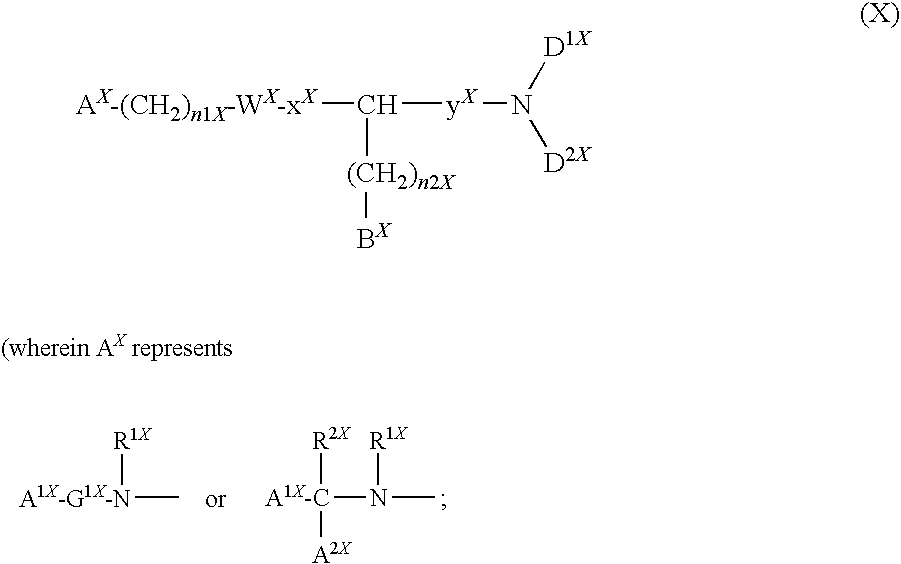Chemokine receptor antagonists and use thereof
a technology of chemokine receptor and antagonist, which is applied in the field of chemokine receptor antagonists, can solve the problems of causing malignant tumors, affecting immune function, and deteriorating gradually in the field of immunological functions,
- Summary
- Abstract
- Description
- Claims
- Application Information
AI Technical Summary
Benefits of technology
Problems solved by technology
Method used
Image
Examples
example 1
2-formyl-N,N-dimethyl-1H-imidazole-1-sulfonamide
To an acetonitrile (500 mL) solution of 1H-imidazole-2-carboaldehyde (64 g) and triethylamine (140 mL), dimethylsulfamoyl chloride (100 g) was added at room temperature. The reaction solution was stirred at 50° C. for 16 hours. After the reaction solution was cooled to room temperature, the precipitated crystal was removed by filtration and the filtrate was concentrated under reduced pressure. The residue was washed with ethyl acetate to obtain the crude title compound. The washing was washed with saturated brine and then dried over anhydrous sodium sulfate. After removing the anhydrous sodium sulfate by filtration, the filtrate was concentrated. The residue was purified by silica gel chromatography (ethyl acetate) to obtain the crude title compound. The obtained compound was combined with the crystal obtained previously and then washed with ether to obtain the title compound (88.32 g) having the following physical properties.
TLC: Rf 0...
example 2
2,2′-[(benzylimino)bis(methylene)]bis(N,N-dimethyl-1H-imidazole-1-sulfonamide)
To a 1% acetate-N,N-dimethylformamide (500 mL) solution of the compound (70 g) obtained in Example 1, benzylamine (17.9 mL) was added at 0° C. To the solution, sodium triacetoxyboron (52 g) was added. The reaction solution was stirred at 0° C. for 30 minutes. To the reaction solution, sodium triacetoxyboron (52 g) was added. The reaction solution was heated to room temperature and then stirred at room temperature for 40 hours. The reaction solution was concentrated under reduced pressure. To the residue, an aqueous 5N sodium hydroxide solution was added, thereby adjusting the pH to 12. The aqueous layer was extracted with ethyl acetate. The combined organic layer was washed with saturated brine and then dried over anhydrous magnesium sulfate. After removing the anhydrous sodium sulfate by filtration, the filtrate was concentrated. Without purifying the residue, the title compound (79 g) having the followin...
example 3
2,2′-[iminobis(methylene)]bis(N,N-dimethyl-1H-imidazole-1-sulfonamide)
To an ethanol (350 mL) solution of the compound (55.7 g) obtained in Example 2, 20% palladium hydroxide-carbon (13.6 g) was added under an argon atmosphere. The reaction mixture was stirred under a hydrogen atmosphere at 60° C. for 6 hours. The reaction mixture was cooled to room temperature and then filtered through Celite. The filtrate was concentrated under reduced pressure. The residue was purified by silica gel chromatography (ethyl acetate:10%-saturated aqueous ammonia-methanol=1:0→8:2) to obtain the title compound (28.5 g) having the following physical properties.
TLC: Rf 0.66 (dichrolomethane:methanol:28% aqueous ammonia=80:20:3);
NMR (CDCl3): δ 7.22 (m, 2H), 6.96 (m, 2H), 4.14 (s, 4H), 2.90 (s, 12H).
PUM
 Login to View More
Login to View More Abstract
Description
Claims
Application Information
 Login to View More
Login to View More - R&D
- Intellectual Property
- Life Sciences
- Materials
- Tech Scout
- Unparalleled Data Quality
- Higher Quality Content
- 60% Fewer Hallucinations
Browse by: Latest US Patents, China's latest patents, Technical Efficacy Thesaurus, Application Domain, Technology Topic, Popular Technical Reports.
© 2025 PatSnap. All rights reserved.Legal|Privacy policy|Modern Slavery Act Transparency Statement|Sitemap|About US| Contact US: help@patsnap.com



